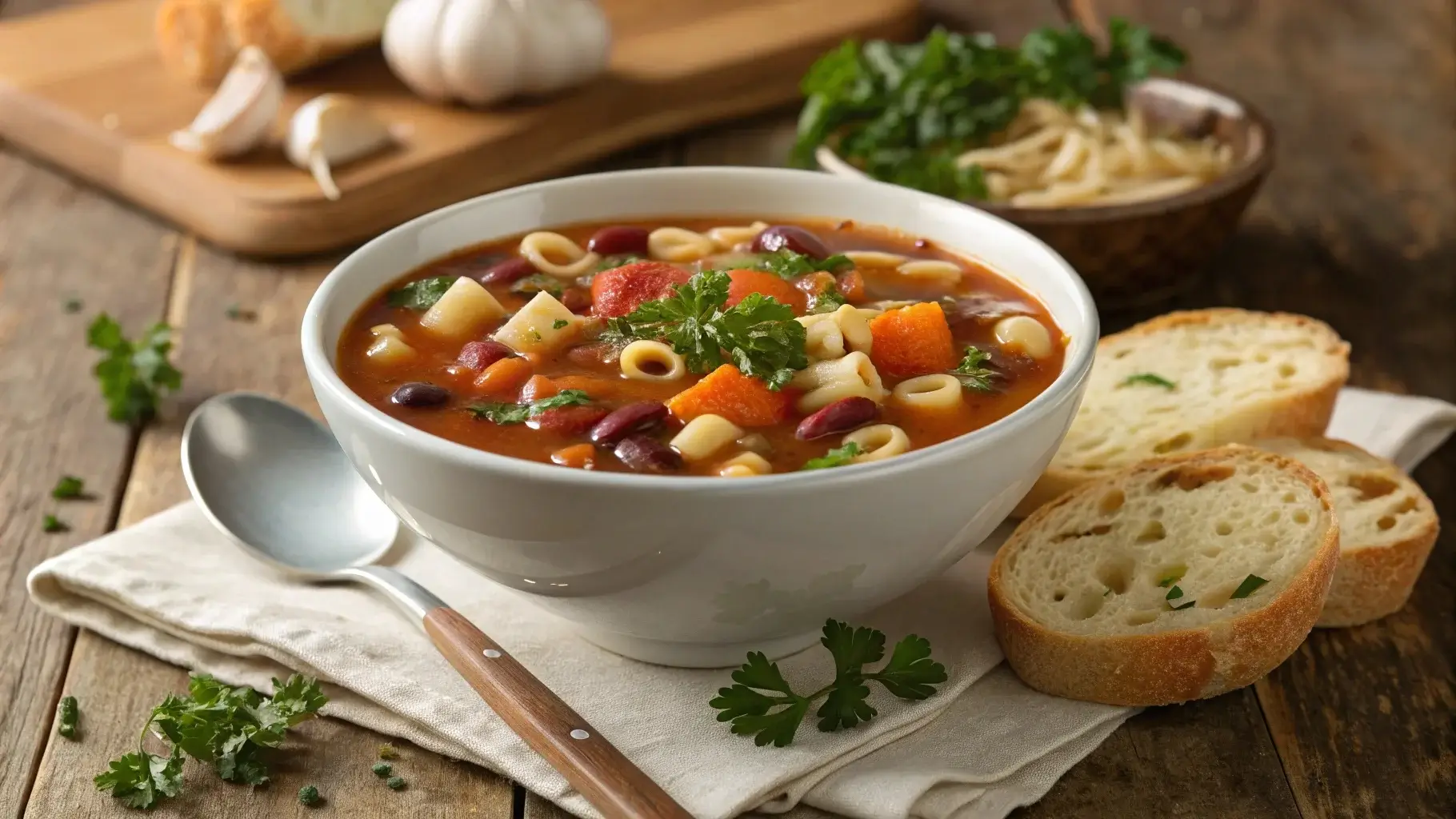There’s something truly magical about a bowl of warm, comforting soup on a chilly day, and the olive garden minestrone soup recipe is no exception. This hearty dish brings together an array of fresh vegetables, tender pasta, and rich broth in every spoonful. Whether you’re craving the classic flavors of Italy or simply looking for a healthy yet satisfying meal, this recipe delivers on all fronts. In this article, we’ll explore its history, essential ingredients, step-by-step instructions, creative variations, and serving tips to help you recreate that iconic restaurant flavor right at home.
To give you a glimpse of what’s ahead, let me share a little story. My husband Momo and I decided to try making our first olive garden minestrone soup recipe one weekend evening. It wasn’t perfect—Momo overcooked the pasta slightly, and I added too much salt—but the end result was still delicious! That experience taught us that even small mistakes can lead to big flavor surprises. Now, let’s dive into the details!
Table of Contents
Introduction to Olive Garden Minestrone Soup Recipe
Why Olive Garden Minestrone Soup Stands Out
The olive garden minestrone soup recipe has captured the hearts of many with its vibrant blend of flavors and textures. Unlike other soups, minestrone stands out because it combines hearty ingredients like beans, pasta, and an assortment of vegetables into one comforting pot. At Olive Garden, their version adds a special touch that makes it irresistible—rich tomato-based broth, perfectly cooked ditalini pasta, and just the right amount of herbs and spices.
This soup isn’t just about taste; it’s also about nostalgia. For many, it evokes memories of cozy dinners and family gatherings. Its versatility allows cooks to adapt it according to their preferences, making it a favorite among both casual diners and culinary enthusiasts alike.
The Popularity of Minestrone in Italian Cuisine
Minestrone has long been a staple in Italian kitchens, known for its ability to use up leftover ingredients while still delivering robust flavors. With its roots in peasant cooking, this soup emphasizes simplicity and resourcefulness, qualities that continue to resonate today.
Essential Ingredients for Your Olive Garden Minestrone Soup Recipe
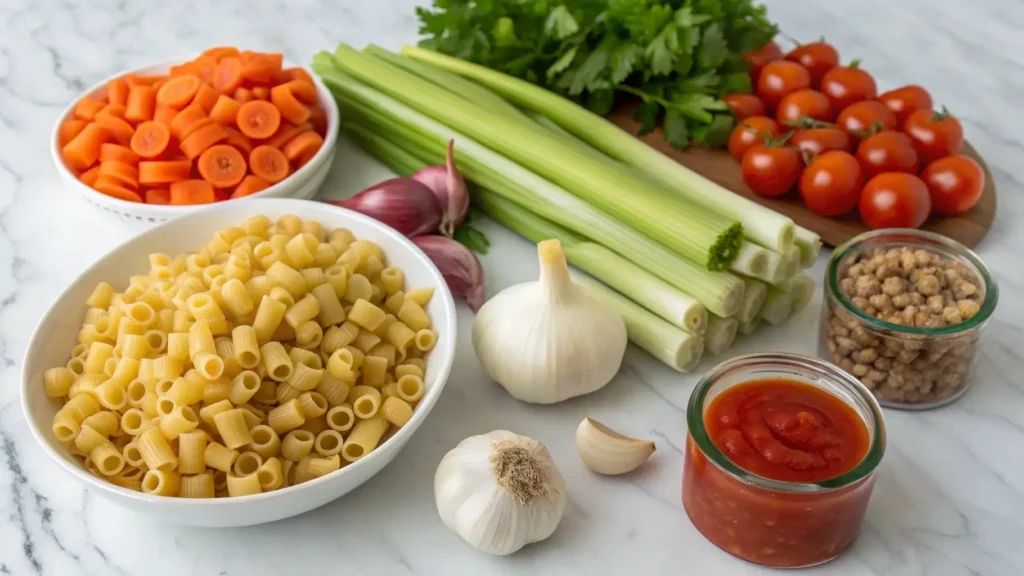
Key Ingredients That Make This Recipe Special
To recreate the authentic taste of olive garden minestrone soup recipe, you’ll need a few key ingredients. Start with high-quality canned tomatoes—they form the base of the rich broth. Add diced carrots, celery, onions, and garlic for depth. Green beans, zucchini, and spinach bring color and nutrition, while kidney beans or cannellini beans provide protein and creaminess. Ditalini pasta is traditional, though other small shapes work well too.
For seasoning, don’t skimp on dried oregano, basil, and thyme—these herbs elevate the flavor profile without overpowering the dish. A pinch of red pepper flakes adds a subtle kick if desired.
Substitutions for Common Ingredients
Not everyone follows the same dietary preferences, so substitutions are key. Swap regular pasta for gluten-free options if needed. Use vegetable broth instead of chicken broth for vegetarian versions. Lentils or chickpeas can replace beans for variety. With these tweaks, anyone can enjoy the deliciousness of olive garden minestrone soup recipe.
Step-by-Step Guide to Making Olive Garden Minestrone Soup Recipe
Preparing the Ingredients
Before diving into your olive garden minestrone soup recipe, preparation is key. Start by chopping vegetables like carrots, celery, onions, and garlic into small pieces for even cooking. Wash and slice green beans and zucchini, then set them aside. If using canned tomatoes, crush them lightly with your hands or a fork to break them down.
For the pasta, measure out the correct amount based on serving sizes. Ditalini is traditional, but elbow macaroni or other small shapes work just as well. For protein, drain and rinse canned beans before adding them to the pot.
Cooking Techniques for Perfect Results
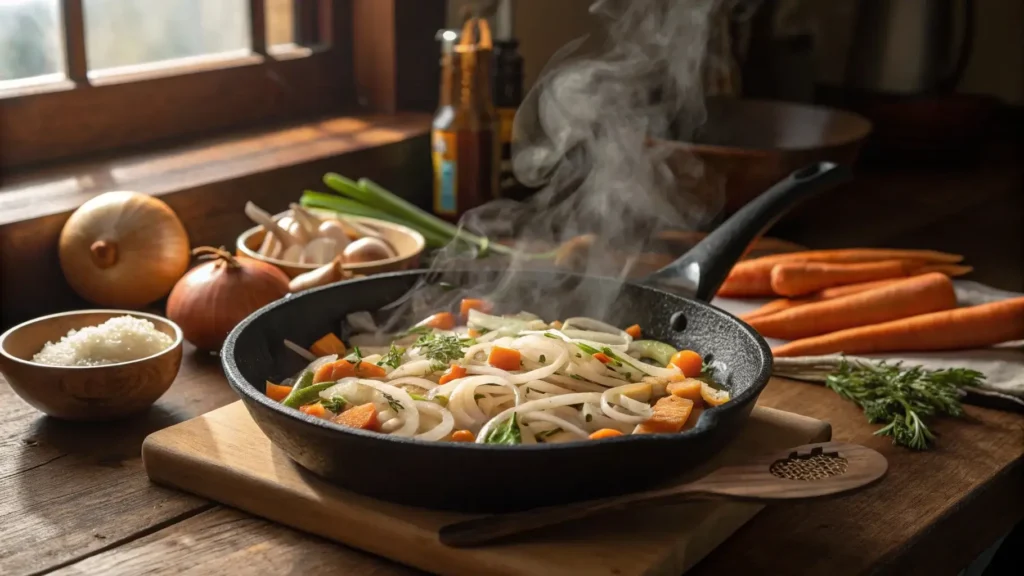
Heat olive oil in a large pot over medium heat. Add diced onions, garlic, and carrots first, sautéing until softened. Stir frequently to prevent burning. Once fragrant, toss in chopped celery, green beans, and zucchini. Cook for a few minutes until slightly tender.
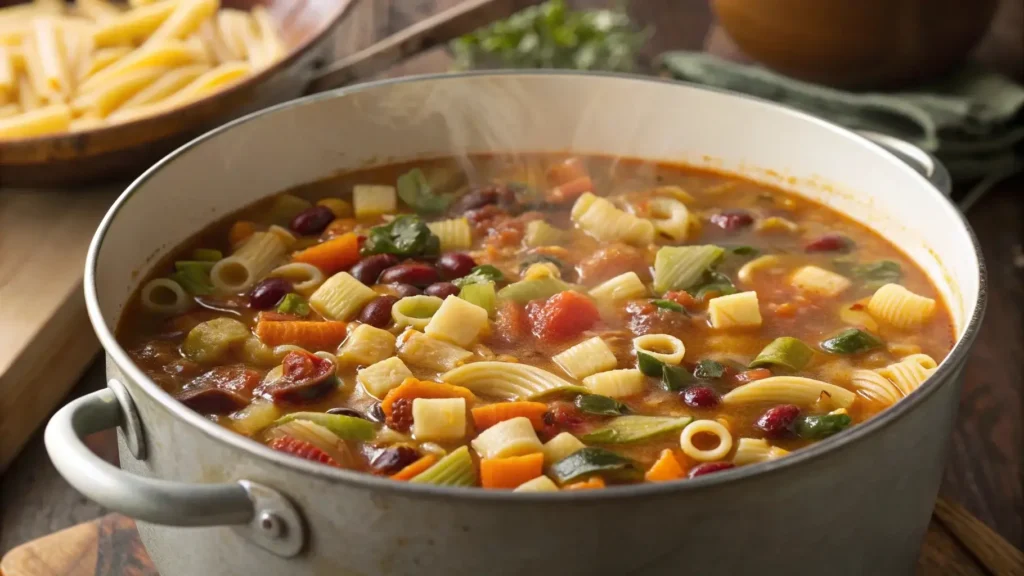
Next, pour in crushed tomatoes, vegetable or chicken broth, and water. Bring the mixture to a boil, then reduce the heat to low and simmer. This step allows flavors to meld together while softening the vegetables. After about 20 minutes, stir in cooked pasta, beans, and spinach. Let everything cook for another 10 minutes to ensure all ingredients are heated through.
Combining Everything Together
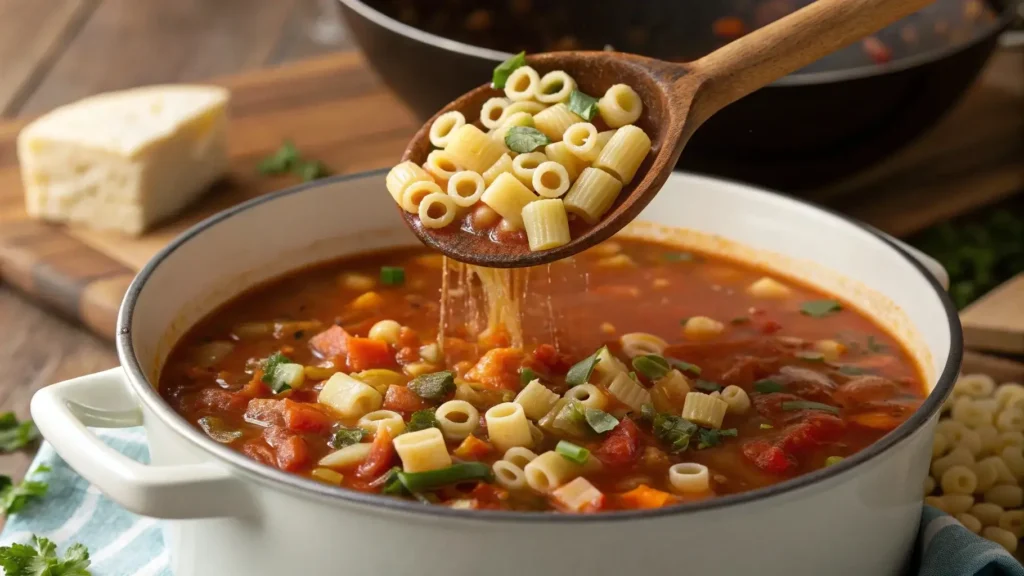
Finally, season generously with dried herbs like oregano, basil, and thyme. A pinch of salt and pepper ties it all together. Ladle the soup into bowls and garnish with grated Parmesan cheese if desired.
Variations of the Olive Garden Minestrone Soup Recipe
Adding Extra Flavors and Textures
One of the joys of working with olive garden minestrone soup recipe is its versatility. Experiment with different seasonings such as smoked paprika, cayenne pepper, or nutritional yeast for a cheesy taste in vegan versions. Fresh herbs like parsley or thyme add aromatic depth. For extra crunch, sprinkle breadcrumbs or croutons on top before serving.
Vegetarian and Vegan Options
To cater to various dietary needs, consider plant-based alternatives. Swap meat-based broths for vegetable stock and omit Parmesan cheese for a fully vegan option. Use lentils or chickpeas instead of kidney beans for added protein. These swaps ensure everyone at the table enjoys this comforting dish without compromising taste.
Whether you stick to tradition or get creative, the possibilities are endless with the olive garden minestrone soup recipe.
For a heartier twist, consider adding sausage to your minestrone. You can find comfort food ideas in our article on Cabbage and Sausage Comfort Food.
Tips for Amateur and Advanced Cooks to Perfect Olive Garden Minestrone Soup Recipe
Beginner-Friendly Tips for Making Olive Garden Minestrone Soup Recipe
If you’re new to cooking with olive garden minestrone soup recipe, start by focusing on the basics. Always use plenty of salted broth when preparing the soup—it enhances the flavor significantly. Follow the recommended cooking time closely to ensure the perfect texture of vegetables and pasta. When sautéing aromatics like onions and garlic, take your time to develop their flavors without burning them. For soups, adding ingredients in stages ensures even cooking and better flavor absorption.
Additionally, don’t hesitate to taste as you go. Seasoning is key, so adjust salt, pepper, or herbs according to your preference. Start simple—classic tomato-based broth with a mix of vegetables—and build confidence before experimenting with more complex variations.
Advanced Techniques for Mastering Olive Garden Minestrone Soup Recipe
For seasoned cooks, adding unique twists takes this dish to the next level. Try incorporating unconventional ingredients like roasted red peppers, caramelized onions, or nutritional yeast for depth. To elevate broths, simmer homemade stock instead of store-bought options for richer flavors. In baked versions, layer minestrone with creamy polenta or cheesy gratin for added indulgence.
Experiment with different types of beans, such as borlotti or flageolet, to cater to various tastes while maintaining authenticity. These small adjustments can transform your already delicious olive garden minestrone soup recipe into something truly remarkable.
Tips for Perfecting Your Olive Garden Minestrone Soup Recipe
Common Mistakes to Avoid
When making olive garden minestrone soup recipe, there are a few common pitfalls to watch out for. One major issue is overcooking the pasta, which can lead to a mushy texture. Always add the pasta toward the end of cooking to prevent it from becoming overly soft. Another mistake is not seasoning the broth adequately—this step ensures every spoonful bursts with flavor. Lastly, failing to simmer long enough may result in underdeveloped flavors, so patience is key.
Techniques for Better Texture and Flavor
To achieve the perfect consistency, stir occasionally while the soup simmers. This prevents ingredients from sticking to the bottom of the pot and ensures even distribution of flavors. For a creamier finish, blend part of the soup using an immersion blender or regular blender before returning it to the pot. Adding fresh spinach near the end of cooking preserves its vibrant color and delicate texture.
Serving Suggestions for Olive Garden Minestrone Soup Recipe
Pairing Ideas for a Complete Meal
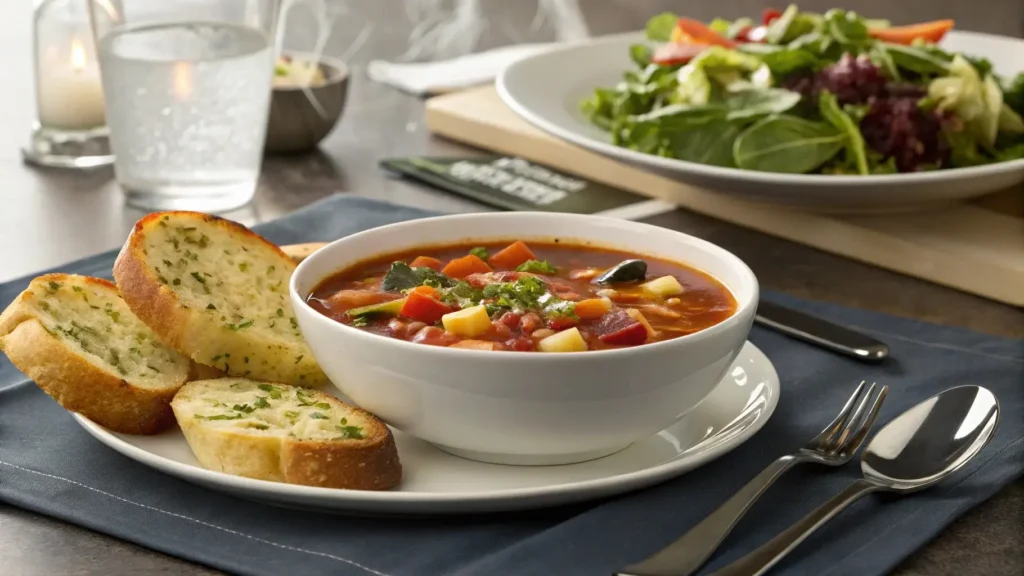
Your olive garden minestrone soup recipe pairs beautifully with simple sides to create a satisfying meal. Serve it alongside freshly baked garlic bread or crusty baguettes for dipping. A side salad dressed with lemon vinaigrette adds freshness without overpowering the rich flavors of the soup.
Creative Ways to Serve Minestrone Soup
Thinking outside the box can elevate your dish even further. Stuff bell peppers with minestrone mixture for a fun presentation, or use mini muffin tins to bake individual portions. No matter how you serve it, this versatile dish guarantees delight!
You can also pair your minestrone soup with a side of garlic bread or even a simple bowl of cheesy hamburger potato soup for a comforting meal.
FAQs bout Olive Garden Minestrone Soup Recipe
Can I Freeze Olive Garden Minestrone Soup?
Yes, freezing olive garden minestrone soup recipe is a great way to enjoy it later. Let the soup cool completely before transferring it to an airtight container or freezer-safe bag. It can last up to three months in the freezer. When reheating, thaw overnight in the fridge and warm gently on the stovetop, adding a splash of water if needed.
Is Olive Garden Minestrone Soup Gluten-Free?
Traditional olive garden minestrone soup recipe contains pasta, so it isn’t gluten-free unless you substitute with gluten-free options like rice or corn-based pasta. Always check labels when using store-bought ingredients.
How Long Does Homemade Minestrone Soup Last in the Fridge?
Stored properly in an airtight container, homemade minestrone lasts about four days in the refrigerator. Reheat portions as needed for best results.
What Are Some Good Side Dishes to Serve with Olive Garden Minestrone Soup?
Pair your olive garden minestrone soup recipe with crusty garlic bread, Caesar salad, or cheesy focaccia for a complete meal.
Final Thoughts on Olive Garden Minestrone Soup Recipe
Whether you’re craving comfort food or seeking inspiration for a quick weeknight dinner, the olive garden minestrone soup recipe delivers hearty flavors and satisfying textures in every bite. Its adaptability makes it suitable for soups, salads, casseroles, and more. With just a little creativity, you can transform this humble dish into something extraordinary. So gather your ingredients, follow these tips, and let your culinary journey begin. Once you taste the results, you’ll wonder why you didn’t try this sooner!
